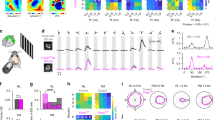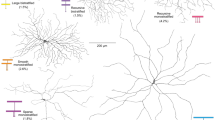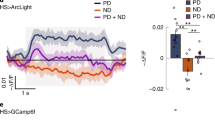Abstract
A direction-selective (DS) retinal ganglion cell responds well to a small object moving within its receptive field center, but less well when there is also a moving stimulus in the surrounding area; this has been described as tuning for local motion. We show here an additional selectivity, such that the surround has less effect if there is a discontinuity—that is, a difference in spatial phase, spatial frequency or velocity—between the center stimulus and that present in the surround.
This is a preview of subscription content, access via your institution
Access options
Subscribe to this journal
Receive 12 print issues and online access
$209.00 per year
only $17.42 per issue
Buy this article
- Purchase on Springer Link
- Instant access to full article PDF
Prices may be subject to local taxes which are calculated during checkout



Similar content being viewed by others
References
Barlow, H.B. & Levick, W.R. J. Physiol. (Lond.) 178, 477–504 (1965).
Wyatt, H.J. & Daw, N.W. J. Neurophysiol. 38, 613–626 (1975).
Euler, T., Detwiler, P.B. & Denk, W. Nature 418, 845–852 (2002).
Fried, S.I., Münch, T.A. & Werblin, F.S. Nature 420, 411–414 (2002).
Grzywacz, N.M., Tootle, J.S. & Amthor, F.R. Vis. Neurosci. 14, 39–54 (1997).
Taylor, W.R. & Vaney, D.I. Trends Neurosci. 26, 379–385 (2003).
Werblin, F.S. Science 175, 1008–1010 (1972).
Werblin, F.S., Maguire, G.W., Lukasewiewicz, S.R., Eliasof, S.R. & Wu, S. Vis. Neurosci. 1, 317–329 (1988).
He, S. & Levick, W.R. Neurosci. Lett. 285, 25–28 (2000).
Stasheff, S.F. & Masland, R.H. J. Neurophysiol. 88, 1026–1039 (2002).
Chiao, C.-C. & Masland, R.H. J. Neurosci. 22, 10509–10513 (2002).
Author information
Authors and Affiliations
Corresponding author
Ethics declarations
Competing interests
The authors declare no competing financial interests.
Supplementary information
Supplementary Fig. 1.
Suppression of the center response by an optic flow stimulus. Since stimulation of the surround does not, by itself, cause responses from the ganglion cell, it is often termed a suppressive or silent surround. Such inhibitory surrounds, tested by Werblin and later investigators using windmill stimuli, are a general feature of many retinal ganglion cells in cold-blooded vertebrates and in the cat 1-3. We confirmed that a classic silent surround exists for the On-Off direction selective cell, using windmill stimuli (Supplementary Fig. 2) and this standard optic flow stimulus. The firing of the DS cell is depressed by the presence of a moving background, but the density and direction of the movement have little effect. The center of the receptive field was stimulated by a square wave grating (1.88 cycle/mm) moving in the preferred direction at 1.88 Hz. The surround of the receptive field was stimulated by random dots moving coherently at the same speed as the center grating in one of eight directions. Conventions as in figure 1. The responses are normalized to the maximum of each cell's response to the center stimulus presented alone. Data points show mean ± s.e.m. for 10 cells. 1. Werblin, F.S. Science 175, 1008-1010 (1972). 2. Werblin, F.S., Maguire, G.W., Lukasiewicz, S.R., Eliasof, S.R. & Wu, S. Vis. Neurosci. 1, 317-329 (1988). 3. Enroth-Cugell,C. & Jakiela,H.G. J. Physiol. 302, 49-72 (1980). (PDF 159 kb)
Supplementary Fig. 2.
Spatial resolution of the inhibitory subunit. In our experiments, the inhibitory effect of the surround stimulus appeared to be quite local. A surround grating shifted by 180° from the center stimulates virtually the same total area of the surround as one in phase with the center, yet the in-phase grating inhibits the response and the out-of-phase grating does not. Thus, the inhibitory subunit in our experiments appears to make its outputs only in its own immediate vicinity. The effects of the annular masks suggest that the subunit in these experiments has a diameter of ≃200 μm. This conclusion is consistent with the result illustrated here, where windmill vanes lost their effectiveness at a width finer than ≃200 μm. This subunit is smaller than the total size of the receptive field and dendritic field of the DS ganglion cell, which occupy ≃500 μm at the retinal eccentricity studied. This level of spatial resolution and the lack of spatial pooling both suggest that the synaptic inhibition occurs in the inner retina (the horizontal cell network spreads too widely to account for a 200 μm subunit), presumably mediated by a medium-field amacrine cell. Conventions as in figures 1-4, scale bar 500 μm. Responses are normalized to the response to the center alone. Mean ± s.e.m. for 12 cells. (PDF 90 kb)
Rights and permissions
About this article
Cite this article
Chiao, CC., Masland, R. Contextual tuning of direction-selective retinal ganglion cells. Nat Neurosci 6, 1251–1252 (2003). https://doi.org/10.1038/nn1147
Received:
Accepted:
Published:
Issue Date:
DOI: https://doi.org/10.1038/nn1147
This article is cited by
-
Neural mechanisms of contextual modulation in the retinal direction selective circuit
Nature Communications (2019)
-
Directionally selective retinal ganglion cells suppress luminance responses during natural viewing
Scientific Reports (2016)
-
Parallel processing in the mammalian retina
Nature Reviews Neuroscience (2004)



